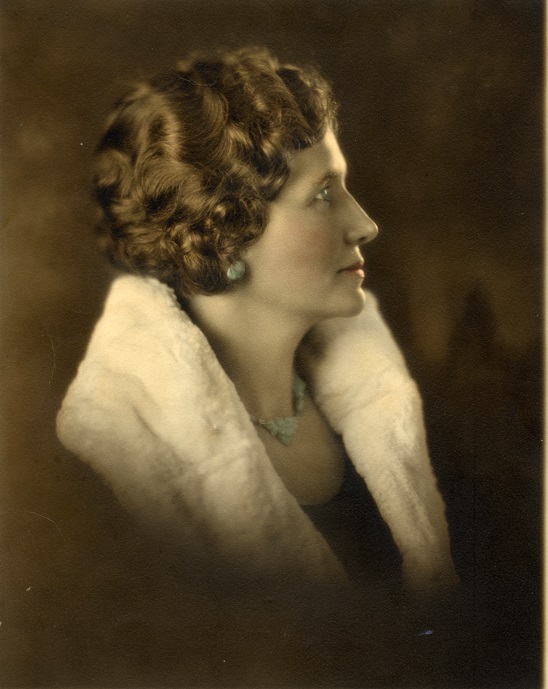Mabel Welch: Pioneer Woman Architect
Mabel Clair Welch was born on November 8, 1890, on her grandfather’s plantation near Longtown, Panola County, Mississippi. In 1899, Mabel’s father, Martin Luther Vanderburg, Junior, decided to move his family to Northeast Texas With their neighbors, the Blackburns and the McBeths, the Vanderburgs departed Mississippi for Texas in covered wagons and herding their livestock. The three families arrived in Texarkana, Arkansas, after four weeks of travel, and in November 1899, they reached their destination of DeKalb, Texas. Mabel attended Hubbard grade school and DeKalb High School, where she graduated in 1910. After graduation, she served an apprenticeship in millinery and interior decorating, and during this time she met Malcolm Hiram Welch. On February 28, 1915, after a five-year courtship, the couple married in DeKalb.
Prior to this marriage, Malcolm Welch had built a number of tenements on farmland near DeKalb, and Mabel became interested in her husband’s occupation. Soon, however, she became concerned for her husband’s health. Malcolm had been diagnosed with tuberculosis by an Army physician when he underwent a physical examination for military service about the time the United States entered the Great War. The doctor prescribed a dry, warm climate; so the young couple decided to move to El Paso. Mabel and Malcolm moved to West Texas in 1916, and he soon began building and financing houses in El Paso. Mabel assisted her husband by drafting floor plans and designs for the houses. Three years after their arrival in the west, their son Elvin was born on December 17, 1919, and by the following year, Malcolm’s home-construction business was well established. Malcolm and Mabel worked together to grow their business; once he completed a house, she would decorate its interior. They would live in the house until a buyer purchased the home. For four years, Malcolm and Mabel built and decorated houses in East El Paso, the Highland Park addition, and the Lower Valley.
In 1924, however, Malcolm’s health began to deteriorate. Mabel assumed additional responsibilities, both in the home caring for her ailing husband and young son and in the business by drafting plans for home construction. During this time, Mabel designed and built her family’s home at 3131 Wheeling Avenue. Although Malcolm’s health was poor, he retained an active role in the business by advising his wife on construction techniques, construction crew management, and financing methods. Mabel’s work centered on Wheeling Avenue, where she built nine homes on that street’s 3100 block and a total of fifteen along that avenue. Mabel began to design homes primarily in the Spanish Colonial Revival style; her first home in this style is located at 2731 Wheeling. As the business succeeded, Malcolm’s condition declined, and on July 17, 1927, he lost his fight with tuberculosis. On the route to the hospital in what proved to be his final days, Malcolm and Mabel passed by the house at 2731 Wheeling, and upon seeing its clean lines and balanced proportions, he said to his wife, “It’s very beautiful.” Mabel later stated she realized his smile and words reassured her that she would succeed as a home designer.
In 1929, Mabel and her son Elvin vacationed in California, and during the trip, she studied Spanish-style architecture to gather ideas in her home designs in El Paso. As the decade ended and the 1930s began, Mabel designed many Spanish Colonial Revival-style homes. According to her son, she designed and built perhaps as many as 1,500 such homes, with the majority of them in El Paso. Her designs were predicated upon research trips to California, Mexico, and San Antonio, and she found much usefulness in the red-clay tile roofs, wrought iron grilles, balconies, and white stucco exteriors that characterize Spanish-influenced domestic architecture. On a formal academic level, she studied architecture at the University of Chicago in the mid-1930s. By 1935 Mabel’s solid reputation as a designer had been assured, and in that year Mayor Ray E. Sherman and the City Council commended her for directing the change from the Bungalow style to the more appropriate Spanish Colonial Revival style for El Paso. Four of her home designs were featured in Planning Your Home for Better Living (1945), authored by Clarence W. Dunham and Milton D. Thalberg and used as a textbook at Yale University.
Regarding her architectural career, she practiced her craft at a time when very few women worked in the profession, and without a doubt, the challenges confronting her were numerous and difficult. An individual of lesser character may have succumbed to the obstacles, but she persevered, and in large part, many El Paso neighborhoods are architecturally richer because of her will and sense of purpose.
From “Mabel Clair Welch” by Tori Ainsworth,Password

